A 10-nm Spectral Resolution Hyperspectral LiDAR System Based on an Acousto-Optic Tunable Filter
Abstract
1. Introduction
- (1)
- The AOTF-HSL solution is proposed, designed, and tested in laboratory conditions. The designed AOTF-HSL operates on a spectrum range from 500 nm to 1000 nm with a 10 nm spectral resolution. The instrument represents an advancement related to previous similar instruments in allowing genuinely hyperspectral (continuous) data to be generated rather than discrete multispectral data. The new system also represents a significant advance in terms of the number of channels available. The laser emission unit consists of an SCL and an AOTF device, ensuring that different wavelengths of the laser beam can be emitted at each time slot. This design allows continuous wavelength selection of the laser pulse in the time dimension and also the filtered pulse at the exit of the transmitted component for better eye safety. Additionally, such a time-multiplexing solution is different with spectrograph based HSL.
- (2)
- Distance measurement capabilities are marginally addressed with a basic demonstration and simple precision assessment. The range precision or range stability over 51 spectral channels of the AOTF-HSL is preliminarily evaluated with a simple test case, four standard reflection boards (100%, 70%, 40%, and 20%) placed at a measured distance of 37.5 meters, and the random range errors can be observed.
- (3)
- In order to precisely calibrate the HSL intensity, the corresponding relationship between the target attribute and the output waveform of HSL is determined based on analysis of the radiation transmission mechanism of HSL, and the calibration model and method are constructed for more accurate quantitative applications of HSL. LiDAR calibration can be achieved by passing a sample of the transmitted signal through the receiver and monitoring the signal from the standard targets both from a spectrometer and the HSL. The calibration tests are conducted using different standard diffuse reflectors (99%, 70%, 40%, 20%, and 5%).
- (4)
- The AOTF-HSL application to agriculture is verified by various vegetation experiments. The spectral profiles of green and yellow leaves from four species are analyzed. The calibrated AOTF-HSL experimental results are also compared with the corresponding measurements from a standard spectrometer (SVC© HR-1024) (hereinafter referred to as the SVC spectrometer). The average spectral difference (absolute value) of the six leaf samples are minor, i.e., 1.37% (green leaf of dracaena), 8.79% (yellow leaf of dracaena), 0.84% (green leaf of aloe), 4.6% (yellow leaf of aloe), 1.36% (green leaf of balata), and 0.77% (green leaf of radermachera), indicating that the AOTF-based high spectral resolution HSL is effective for this application. The results reveal that the potential of this active remote sensing is applicable for vegetation research.
2. Methods
3. Tests and Calibration
3.1. Range Precision Test
3.2. Spectral Profile Test
3.3. Calibration of the Spectral Profile
4. Results and Discussion
4.1. Range Precision Evaluation
4.2. Spectral Profile Calibration
4.3. Spectral Profiles
5. Conclusions
Author Contributions
Acknowledgments
Conflicts of Interest
References
- Kaasalainen, S.; Lindroos, T.; Hyyppä, J. Toward hyperspectral LiDAR: Measurement of spectral backscatter intensity with a supercontinuum laser source. IEEE Geosci. Remote Sens. Lett. 2007, 4, 211–215. [Google Scholar] [CrossRef]
- Hakala, T.; Suomalainen, J.; Kaasalainen, S.; Chen, Y.W. Full waveform hyperspectral LiDAR for terrestrial laser scanning. Opt. Express 2012, 20, 7119–7127. [Google Scholar] [CrossRef] [PubMed]
- Chen, B.W.; Shi, S.; Gong, W.; Zhang, Q.J.; Yang, J.; Du, L.; Sun, J.; Zhang, Z.B.; Song, S.L. Multispectral LiDAR point cloud classification: A two-step approach. Remote Sens. 2017, 9, 373. [Google Scholar] [CrossRef]
- Gong, W.; Sun, J.; Shi, S.; Yang, J.; Du, L.; Zhu, B.; Song, S.L. Investigating the potential of using the spatial and spectral information of multispectral LiDAR for object classification. Sensors 2015, 15, 21989–22002. [Google Scholar] [CrossRef] [PubMed]
- Niu, Z.; Xu, Z.; Sun, G. Design of a New Multispectral Waveform LiDAR Instrument to Monitor Vegetation. IEEE Geosci. Remote Sens. Lett. 2015, 12, 1506–1510. [Google Scholar]
- Hurtt, G.C.; Dubayah, R.; Drake, J.; Schwarz, P.; Pacala, S.; Moorcroft, P. Beyond Potential vegetation: Combining LIDAR data and a height structured model for carbon studies. Ecol. Appl. 2004, 14, 873–883. [Google Scholar] [CrossRef]
- Thomas, V.; McCaughey, H.; Treitz, P.; Finch, D.; Noland, T.; Rich, L. Spatial modelling of photosynthesis for a boreal mixedwood forest by integrating micrometeorological, lidar and hyperspectral remote sensing data. Agric. For. Meteorol. 2009, 149, 639–654. [Google Scholar] [CrossRef]
- Sebastian, B.; León, F.P. Spectral and geometric aspects of mineral identification by means of hyperspectral fluorescence imaging. Tech. Messen. 2015, 82, 597–605. [Google Scholar]
- Li, J.M.; Zhou, M.; Li, C.R. Research on Point Cloud Calculation Method of Airborne Linear Array Push-broom LiDAR. Remote Sens. Technol. Appl. 2013, 28, 1033–1038. [Google Scholar]
- Chen, Y.W.; Zhang, L.; Hu, Y.H.; Zhang, H.M.; Shu, R.; Wang, J.Y. Array Detection Technology of Echo on Earth Observation Laser Imager. J. Infrared Millim. Waves 2004, 23, 169–175. [Google Scholar]
- Zhang, H.; Zhou, M.; Wu, H.; Zhang, D. Application of high-precision matching about multisensor in fast stereo imaging. In Sensors, Systems, and Next-Generation Satellites XIX; International Society for Optics and Photonics: Bellingham, WA, USA, 2015. [Google Scholar]
- Eitel, J.U.H.; Magney, T.S.; Vierling, L.A.; Dittmar, G. Assessment of crop foliar nitrogen using a novel dual-wavelength laser system and implications for conducting laser-based plant physiology. ISPRS J. Photogram. Remote Sens. 2014, 97, 229–240. [Google Scholar] [CrossRef]
- Danson, F.M.; Gaulton, R.; Armitage, R.P.; Disney, M.I.; Gunawan, O.; Lewis, P.E.; Ramirez, A.F. Developing a dual-wavelength full-waveform terrestrial laser scanner to characterize forest canopy structure. Agric. For. Meteorol. 2014, 198, 7–14. [Google Scholar] [CrossRef]
- Douglas, E.S.; Martel, J.; Li, Z.; Howe, G.A.; Hewawasam, K.; Marshall, R.A.; Chakrabarti, S. Finding leaves in the forest: The Dual-Wavelength Echidna Lidar. Geosci. Remote Sens. Lett. 2015, 12, 776–780. [Google Scholar] [CrossRef]
- Muller, J.; Yuen, P. Imaging Lidar Simulator Interface. In NERC-CEOI: Hyperspectral Imaging Lidar (LADAR); University College London: London, UK, 2008; pp. 47–53. [Google Scholar]
- Iain, W.; Caroline, N.; Peter, S.; Jim, J.; Felix, M.; Tim, M.; Genevieve, P. A multispectral canopy LiDAR demonstrator project. IEEE Geosci. Remote Sens. Lett. 2011, 8, 839–843. [Google Scholar]
- Song, S.L. The Principle and Key Technology for Earth Observation Multiple Spectral LiDAR. Ph.D. Thesis, Wuhan University, Wuhan, China, 2010. [Google Scholar]
- Gong, W.; Song, S.L.; Zhu, B.; Shi, S.; Li, F.Q.; Cheng, X.W. Multi-wavelength canopy LiDAR for remote sensing of vegetation: Design and system performance. ISPRS J. Photogram. Remote Sens. 2012, 69, 1–9. [Google Scholar]
- Chen, Y.W.; Räikkönen, E.; Kaasalainen, S.; Suomalainen, J.; Hakala, T.; Hyyppä, J.; Chen, R.Z. Two-channel hyperspectral LiDAR with a supercontinuum laser source. Sensors 2010, 10, 7057–7066. [Google Scholar] [CrossRef]
- Chen, Y.W.; Jiang, C.H.; Hyyppä, J.; Qiu, S.; Wang, Z.; Tian, M.; Li, W.; Puttonen, E.; Zhou, H.; Feng, Z.Y.; et al. Feasibility Study of Ore Classification Using Active Hyperspectral LiDAR. IEEE Geosci. Remote Sens. Lett. 2018, 99, 1–5. [Google Scholar] [CrossRef]
- Wang, Z.; Chen, Y.; Li, C.; Tian, M.; Zhou, M.; He, W.; Zhou, H. A Hyperspectral LiDAR with Eight Channels Covering from VIS to SWIR. In Proceedings of the IGARSS 2018—2018 IEEE International Geoscience and Remote Sensing Symposium, Valencia, Spain, 22–27 July 2018; pp. 4293–4296. [Google Scholar]
- Wang, Z.; Li, C.; Zhou, M.; Zhang, H.; He, W.; Li, W.; Qiu, Y. Recent development of hyperspectral LiDAR using supercontinuum laser. In Hyperspectral Remote Sensing Applications and Environmental Monitoring and Safety Testing Technology; International Society for Optics and Photonics: Bellingham, WA, USA, 2016. [Google Scholar]
- Li, W.; Jiang, C.; Chen, Y.; Hyyppä, J.; Tang, L.; Li, C.; Wang, S.W. A Liquid Crystal Tunable Filter-Based Hyperspectral LiDAR System and Its Application on Vegetation Red Edge Detection. IEEE Geosci. Remote Sens. Lett. 2019, 16, 291–295. [Google Scholar] [CrossRef]
- Wallace, A.M.; McCarthy, A.; Nichol, C.J.; Ren, X.; Morak, S.; Martinez-Ramirez, D.; Woodhouse, I.H.; Buller, G.S. Design and evaluation of multispectral LiDAR for the recovery of arboreal parameters. IEEE Trans. Geosci. Remote Sens. 2014, 52, 4942–4954. [Google Scholar] [CrossRef]
- Specification of Supercontinuum Source SC-OEM. Available online: http://www.yslphotonics.com /Uploads/UserFile/File/1/20180321/5ab241c7d7987.pdf (accessed on 25 March 2019).
- Wagner, W.G. Gaussian decomposition and calibration of a novel small-footprint full-waveform digitising airborne laser scanner. ISPRS J. Photogramm. Remote Sens. 2006, 60, 100–112. [Google Scholar] [CrossRef]
- Kaasalainen, S.; Jaakkola, A.; Kaasalainen, M.; Krooks, A.; Kukko, A. Analysis of Incidence Angle and Distance Effects on Terrestrial Laser Scanner Intensity: Search for Correction Methods. Remote Sens. 2011, 3, 2207–2221. [Google Scholar] [CrossRef]
- Ulaby, F.T.; Moore, R.K.; Fung, A.K. Microwave Remote Sensing: Active and Passive. Vol. 2, Radar Remote Sensing and Surface Scattering and Emission Theory; Addison-Wesley: Reading, MA, USA, 1982. [Google Scholar]
- Ahokas, E.; Kaasalainen, S.; Hyyppä, J.; Suomalainen, J. Calibration of the Optech ALTM 3100 laser scanner intensity data using brightness targets. In Proceedings of the ISPRS Commission I Symposium, Paris, France, 4–6 July 2006. [Google Scholar]
- Kaasalainen, S.; Ahokas, E.; Hyyppä, J.; Suomalainen, J. Study of surface brightness from backscattered intensity: Calibration of laser data. IEEE Geosci. Remote Sens. Lett. 2005, 2, 255–259. [Google Scholar] [CrossRef]
- Pu, R.; Gong, P.; Biging, G.S.; Larrieu, M.R. Extraction of red edge optical parameters from Hyperion data for estimation of forest leaf area index. IEEE Trans. Geosci. Remote Sens. 2003, 41, 916–921. [Google Scholar]
- Darvishzadeh, R.; Atzberger, C.; Skidmore, A.K.; Abkar, A.A. Leaf Area Index derivation from hyperspectral vegetation indices and the red edge position. Int. J. Remote Sens. 2009, 30, 6199–6218. [Google Scholar] [CrossRef]
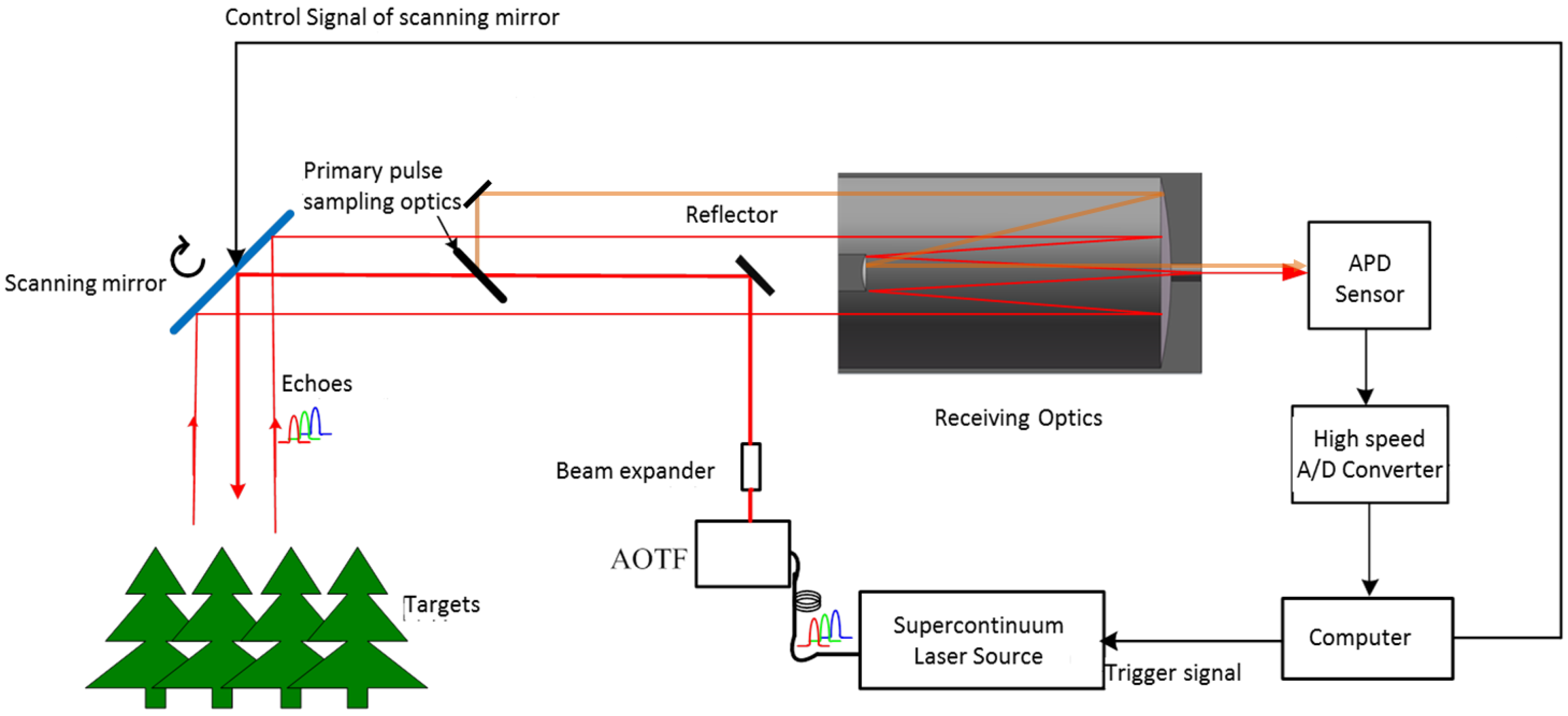
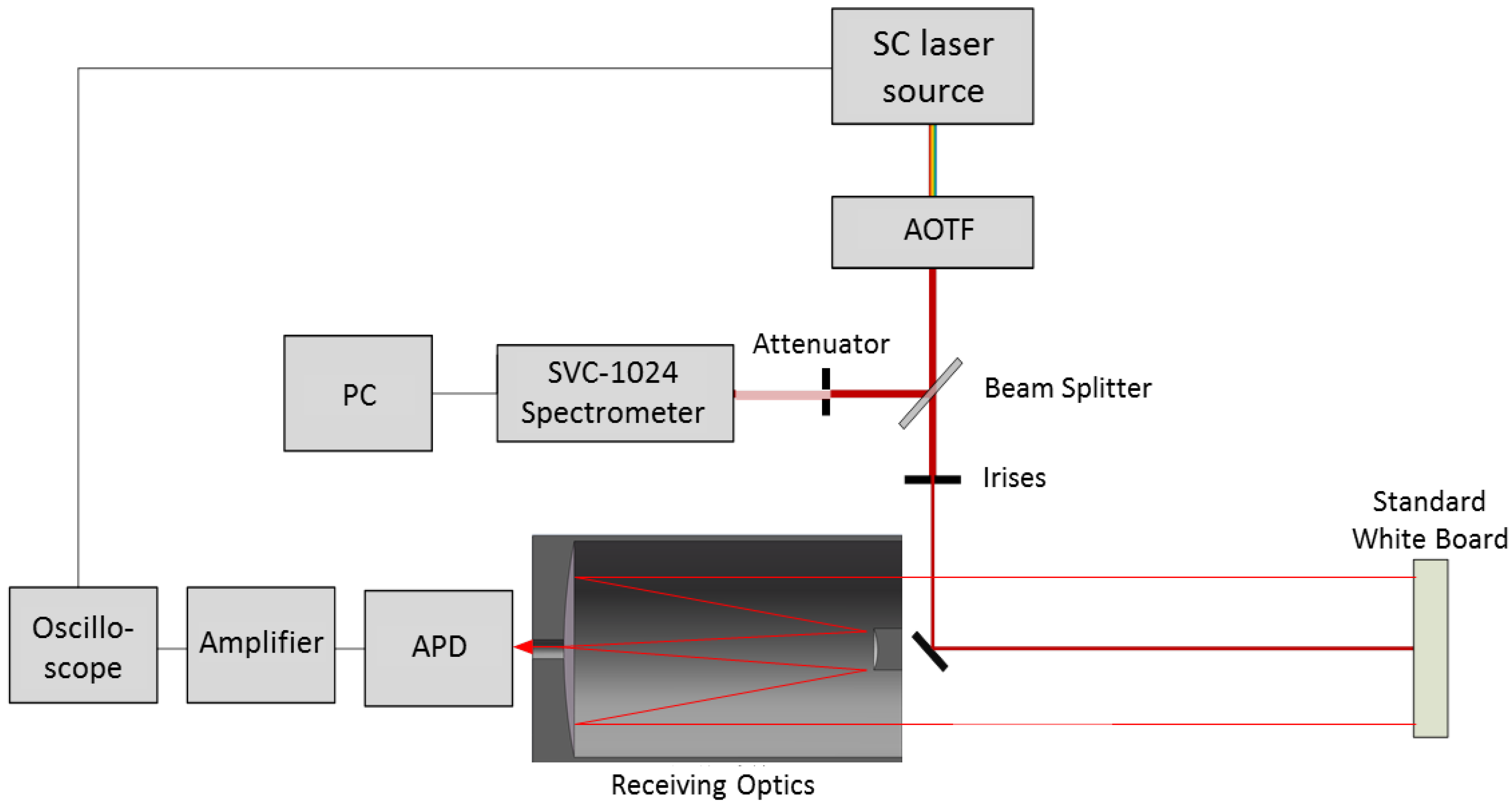
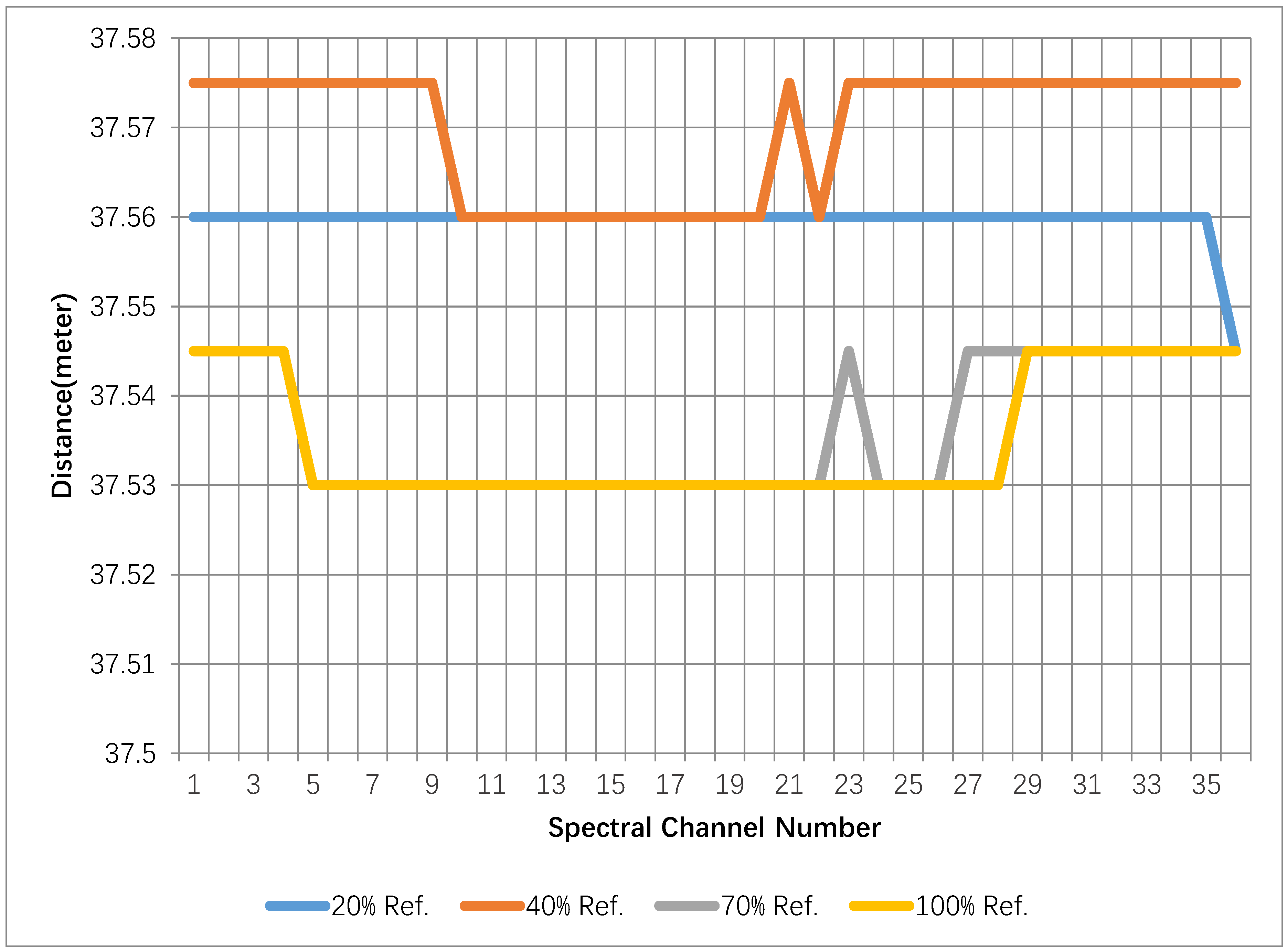
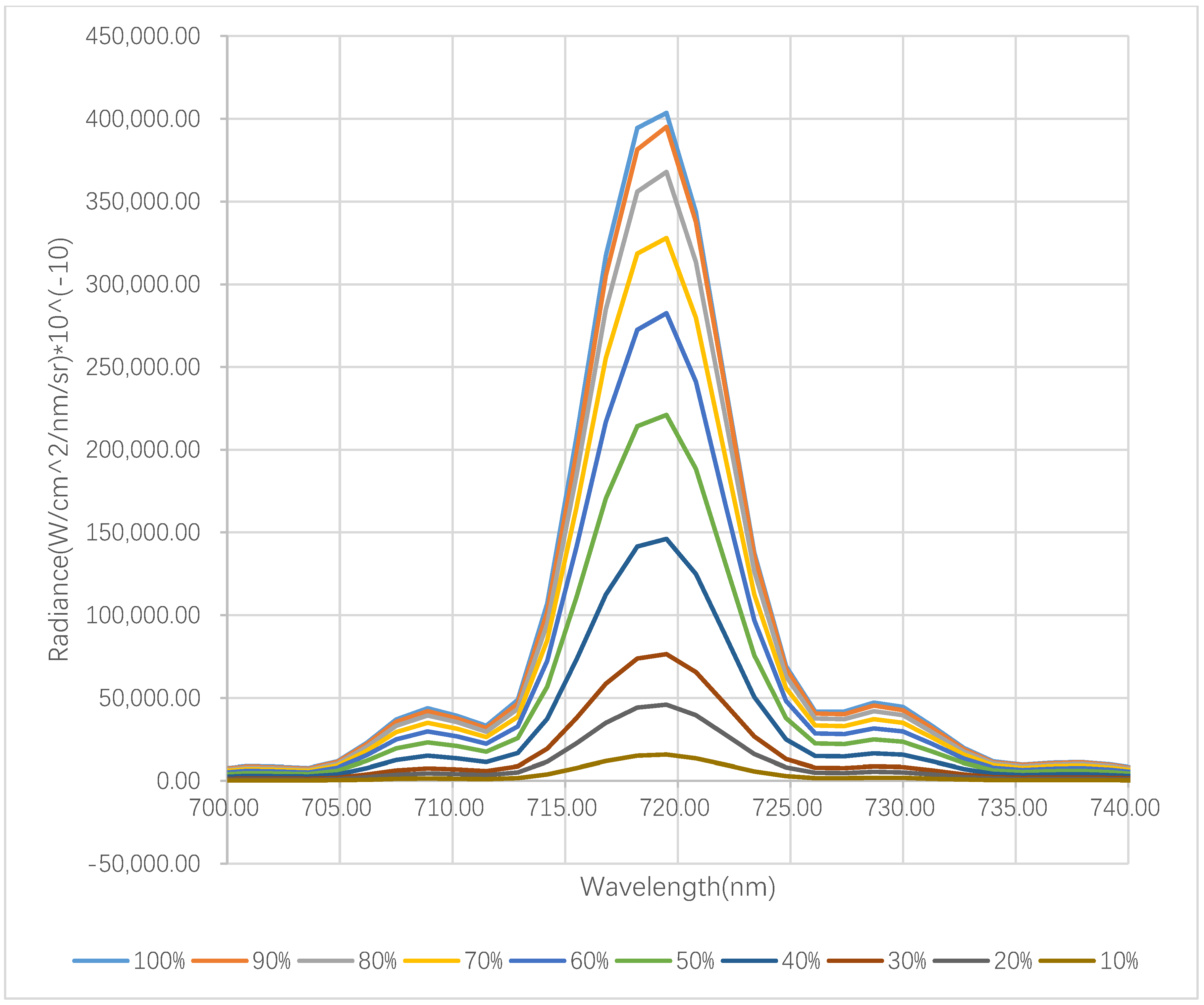
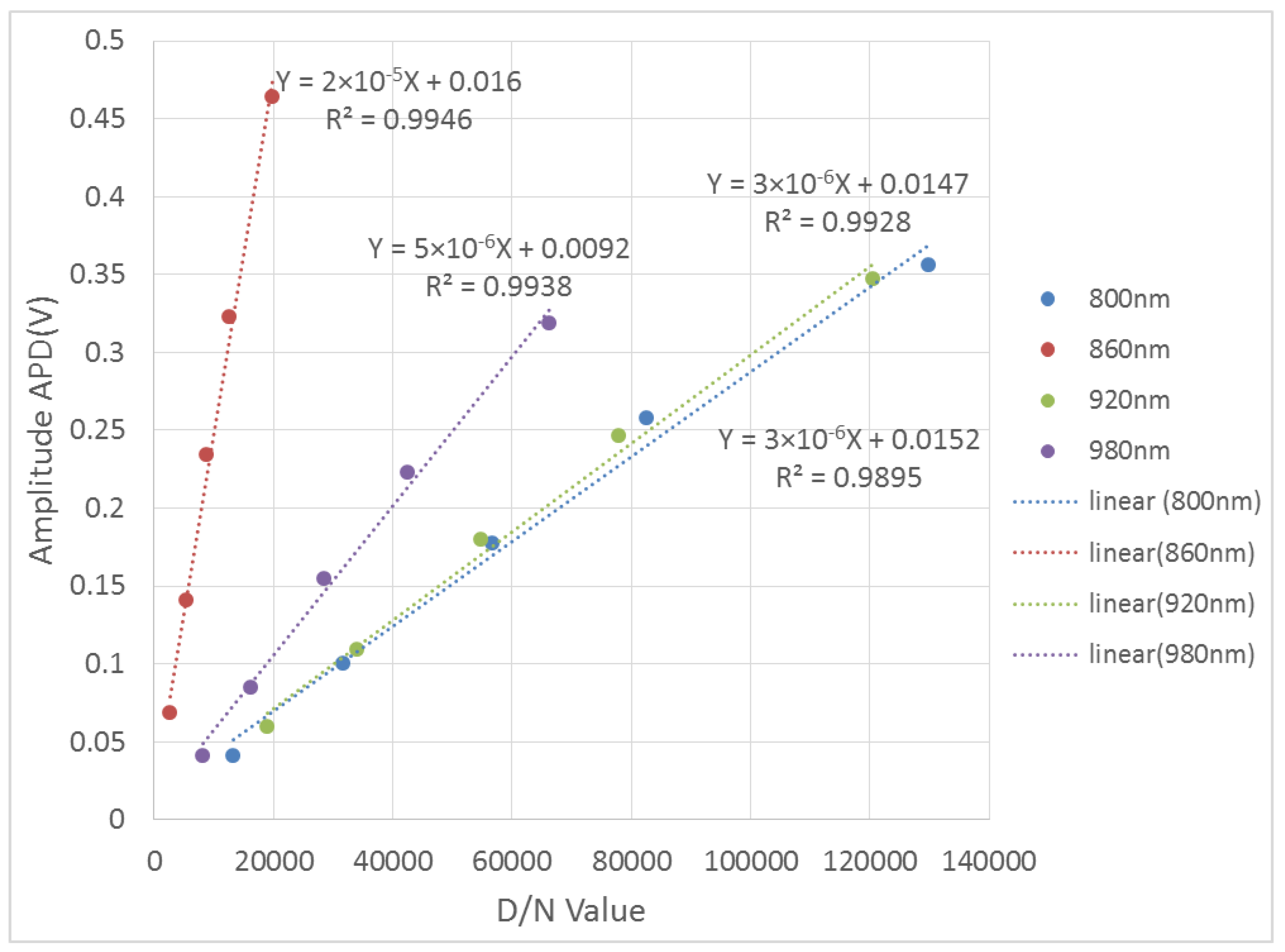
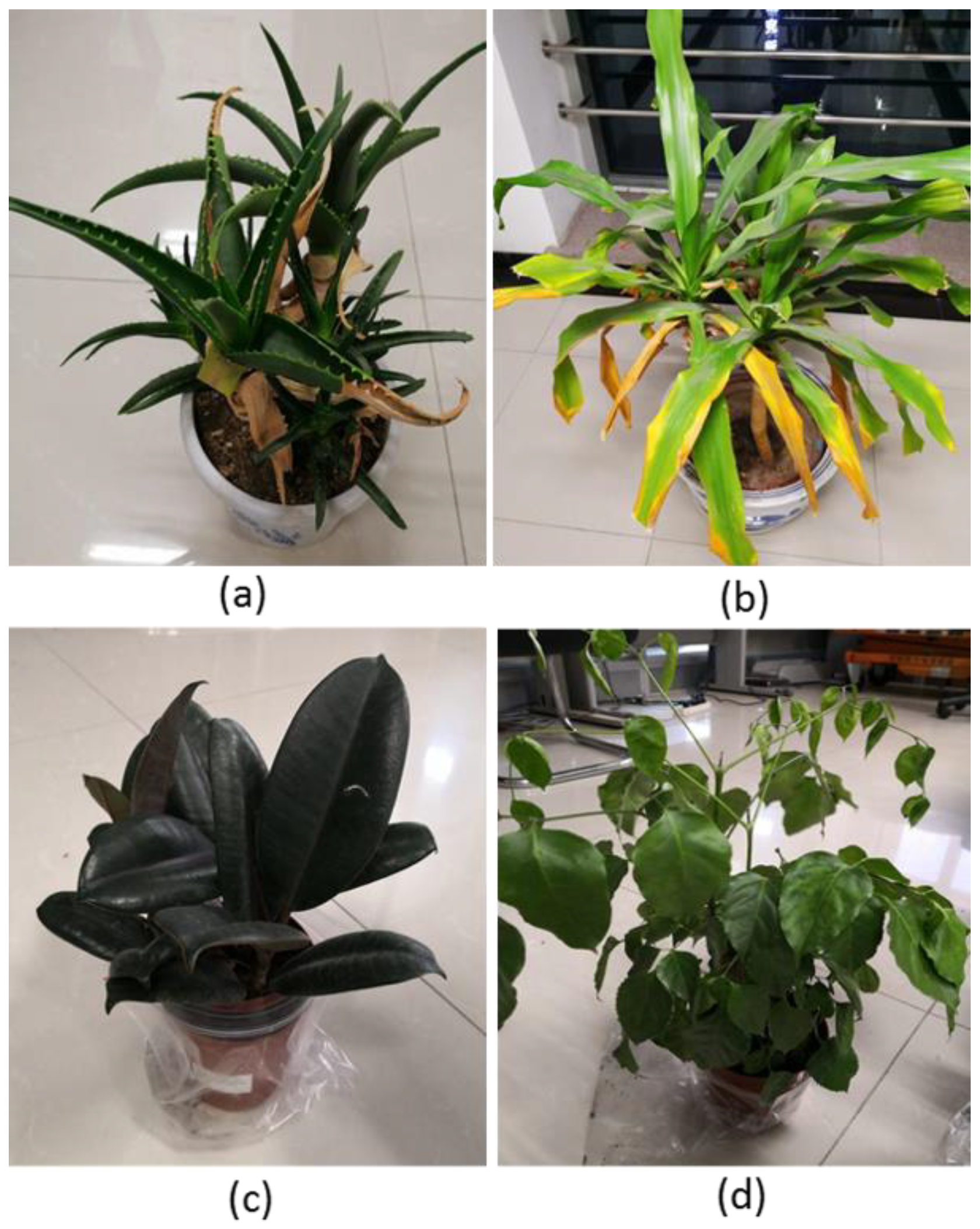
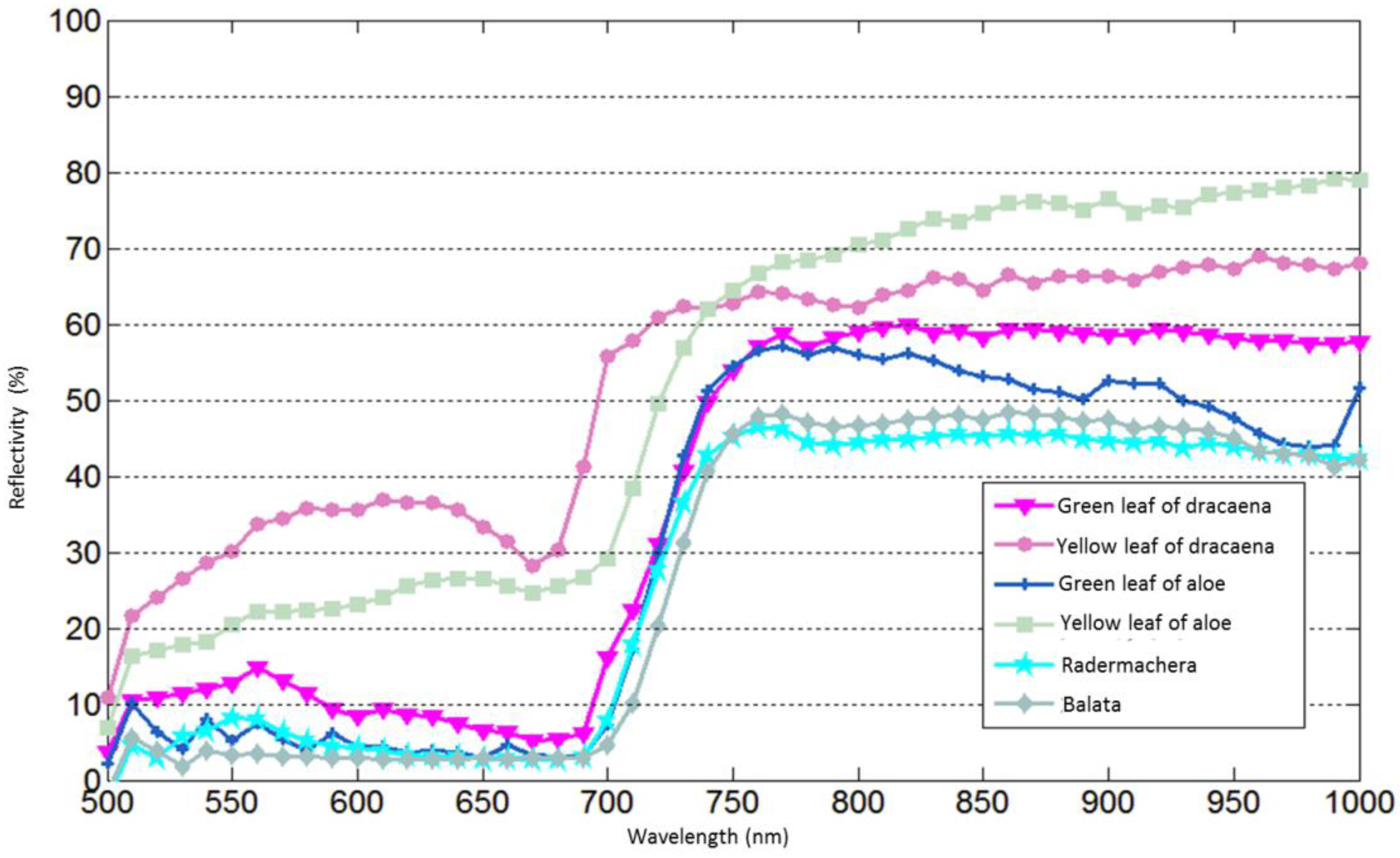
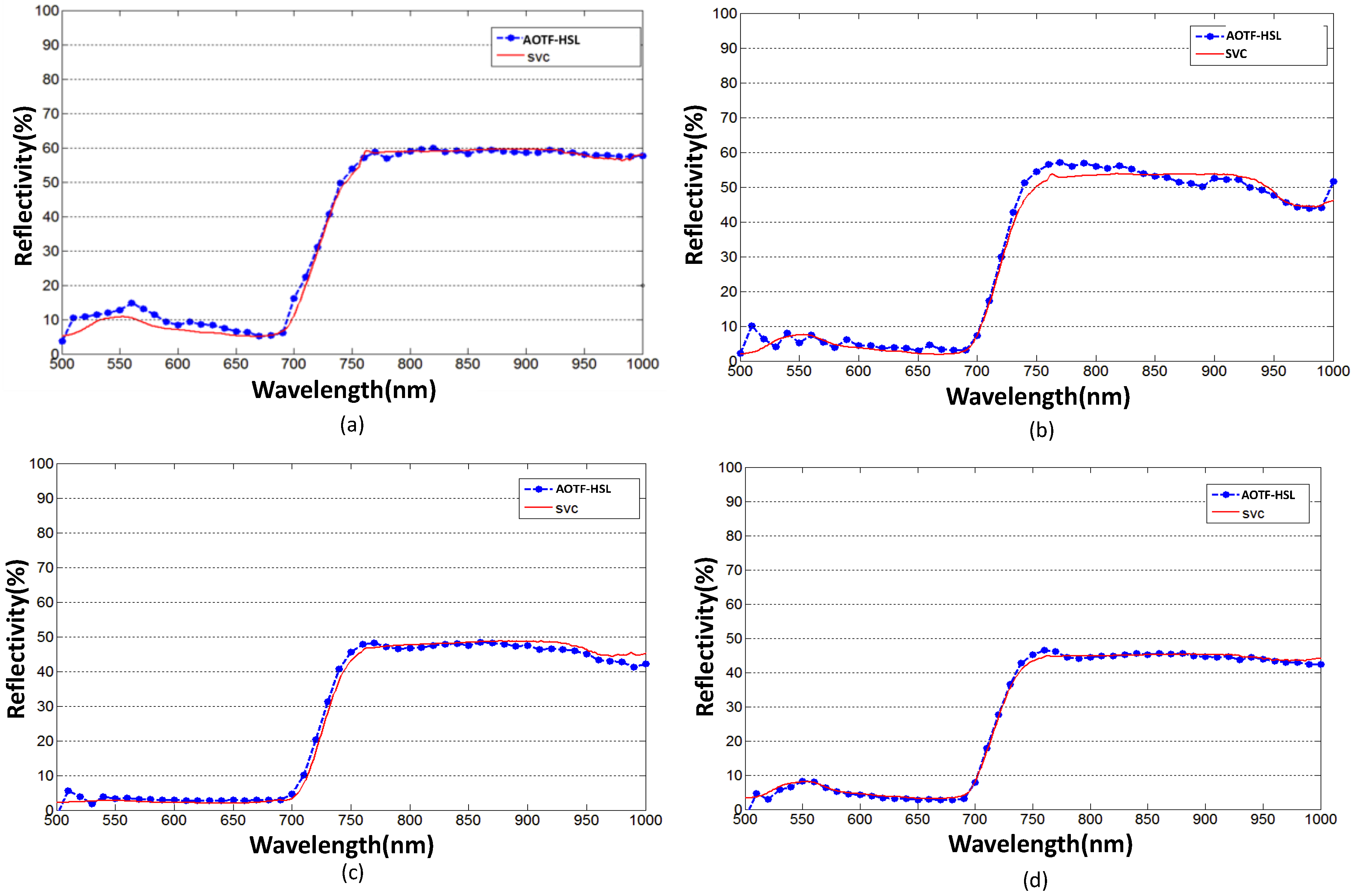
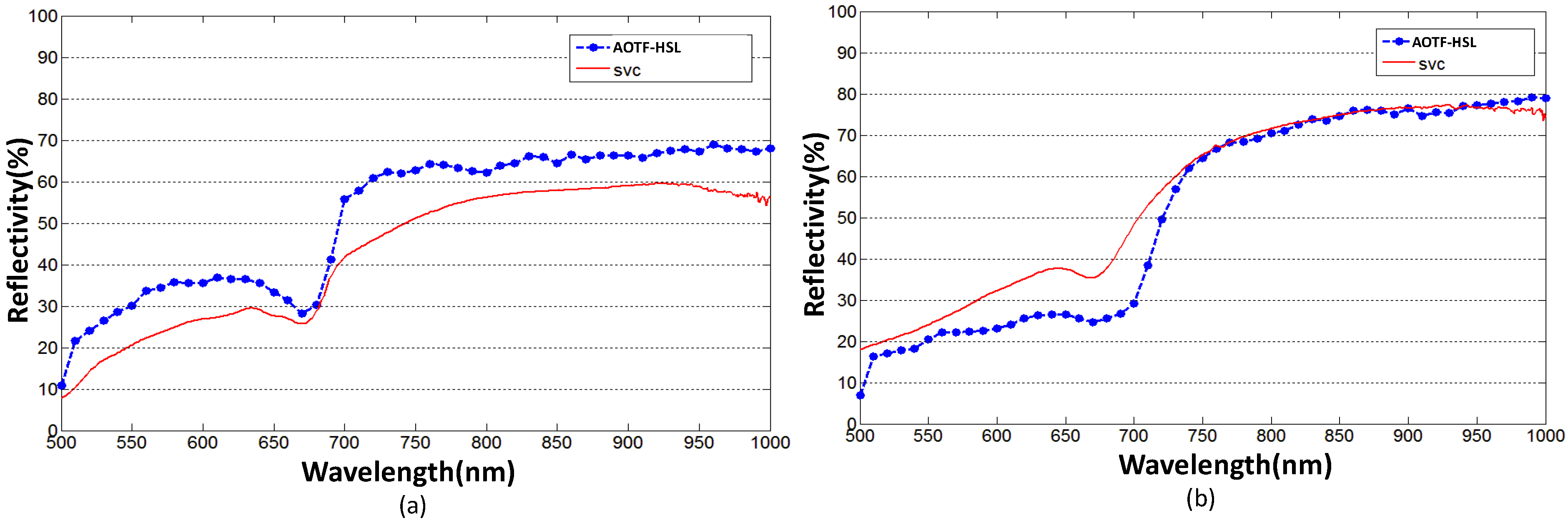
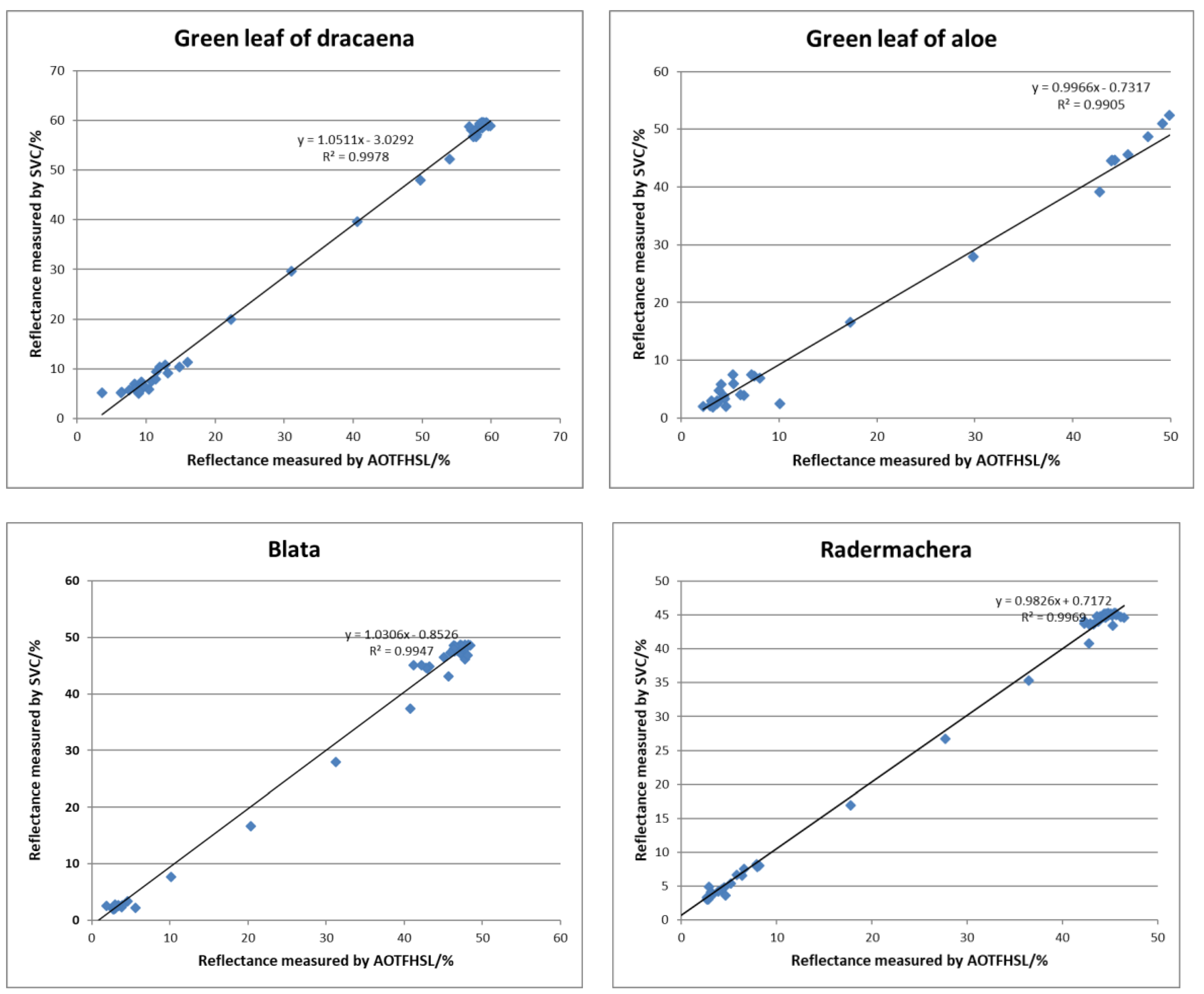
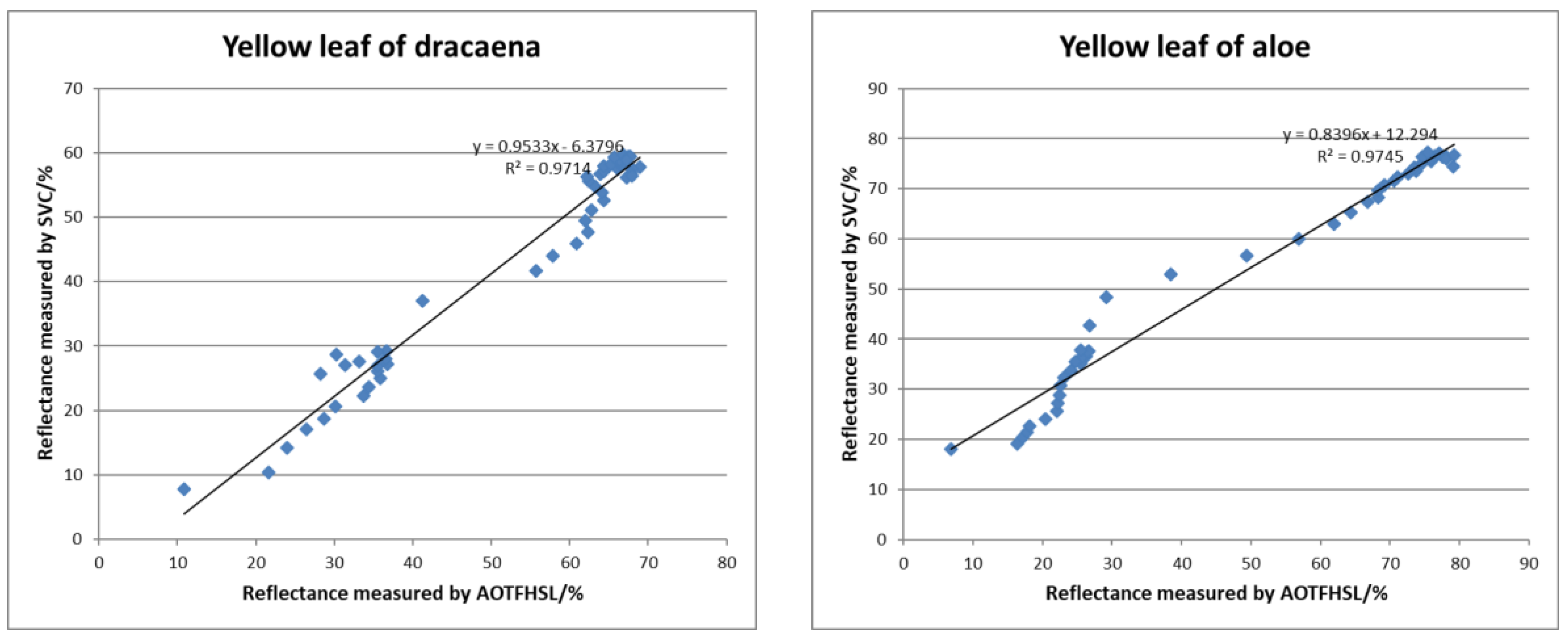
| Parameter | |
|---|---|
| Spectral range | 430–1450 nm |
| Spectral resolution | 2–10 nm |
| Output efficiency | >40% |
| Polarization | Line polarization |
| Beam divergence | 0.4 mill radian |
| Beam diameter (at exit) | 10 mm |
© 2019 by the authors. Licensee MDPI, Basel, Switzerland. This article is an open access article distributed under the terms and conditions of the Creative Commons Attribution (CC BY) license (http://creativecommons.org/licenses/by/4.0/).
Share and Cite
Chen, Y.; Li, W.; Hyyppä, J.; Wang, N.; Jiang, C.; Meng, F.; Tang, L.; Puttonen, E.; Li, C. A 10-nm Spectral Resolution Hyperspectral LiDAR System Based on an Acousto-Optic Tunable Filter. Sensors 2019, 19, 1620. https://doi.org/10.3390/s19071620
Chen Y, Li W, Hyyppä J, Wang N, Jiang C, Meng F, Tang L, Puttonen E, Li C. A 10-nm Spectral Resolution Hyperspectral LiDAR System Based on an Acousto-Optic Tunable Filter. Sensors. 2019; 19(7):1620. https://doi.org/10.3390/s19071620
Chicago/Turabian StyleChen, Yuwei, Wei Li, Juha Hyyppä, Ning Wang, Changhui Jiang, Fanrong Meng, Lingli Tang, Eetu Puttonen, and Chuanrong Li. 2019. "A 10-nm Spectral Resolution Hyperspectral LiDAR System Based on an Acousto-Optic Tunable Filter" Sensors 19, no. 7: 1620. https://doi.org/10.3390/s19071620
APA StyleChen, Y., Li, W., Hyyppä, J., Wang, N., Jiang, C., Meng, F., Tang, L., Puttonen, E., & Li, C. (2019). A 10-nm Spectral Resolution Hyperspectral LiDAR System Based on an Acousto-Optic Tunable Filter. Sensors, 19(7), 1620. https://doi.org/10.3390/s19071620









